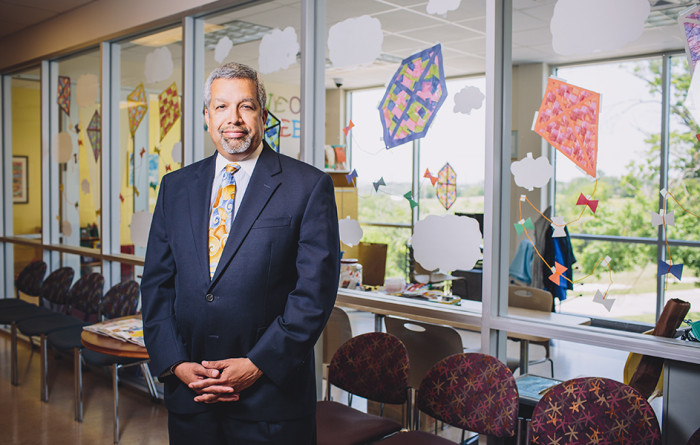In its 24 years, the Center for Child Protection has been helping turn around many young lives for the better, but the Austin-based nonprofit organization has its roots in tragedy.
Three tragedies, to be specific: In the 1980s, three of the children who died of abuse or neglect in Travis County died in circumstances that made it evident the systems in place to prevent such deaths hadn’t worked. One of the boys who were killed died on the day that a letter from Child Protective Services arrived at the desk of the Austin Police Department with suspicions about the boy’s abusive stepfather.
“It’s an example of the disconnect that existed between agency partners,” said Michael Torres, executive director of the Center. “There was cooperation but not collaboration in terms of the investigations going on.”
Travis County District Attorney Ronnie Earl had attended a district conference around the time of the tragic child deaths and learned about the advocacy center model. That model became the basis for the Center for Child Protection, and in 1989 the Center was officially incorporated. It opened its doors in 1992 in a small house on East 32nd Street.
The Center’s mission is simple: to reduce trauma for children during investigations and prosecutions of child abuse. To do that, it acts as a first stop for children who are suspected victims of abuse (whether physical or sexual) or neglect, or witnesses of a violent crime. Children who come through the doors enter a specially equipped and child-friendly facility in which recorded forensic interviews, medical exams, immediate counseling and intervention can take place.
“Rather than have a child go to these individual agencies and have to tell their story again and again and have to be traumatized by the system that’s supposed to be helping them—because some kids would have to tell their story upwards of 15 times—instead, let’s bring investigators to the children,” said Torres of the Center’s model.
A vast majority of the children who come to the Center are brought in by someone in the family who is concerned about the child’s well-being, like a parent or grandparent, Torres added. Ideally, and in most cases, those kids go from the Center to a family member’s home and work with the Center’s staff as they go through the system and receive such services as medical attention and therapy.
If a family member’s home, separate from the residence of the alleged abuser, isn’t available, then children go into the foster care system. Torres said that only 15 percent of the children the Center works with have already been removed from their homes by CPS.
In situations where children are placed in foster homes or with adoptive families, it’s entirely possible that the new parents are gay or lesbian couples. But Torres said for legal reasons, the Center doesn’t keep track of that information. The state doesn’t either, although on a nationwide basis it seems that adoption by same-sex couples is on the rise. According to data from Gary Gates, a demographer from UCLA, roughly 4 percent of the adopted population in the U.S. live in homes with same-sex parents. According to U.S. Census data, the number of children overall in same-sex families is also on the rise.
Torres said the Center is an open and diverse workplace where employees of any sexual orientation can feel comfortable. He’s more concerned with the work being done than personal lives—and there’s plenty of work.
This year the Center has seen, on average, 20 cases more per month than at the same time last year. While Torres is cautious not to say that points to a definite trend, he did say that April brought the largest number of interviews the Center has ever done in one month.
There may be a silver lining to that news. At this time last year, CPS had only 23 caseworkers for the region, significantly fewer than the 96 the agency was supposed to have. Since then, the state has allowed them to hire the number of caseworkers they need, which means cases that might have been closed quickly before are now coming to the Center.
Torres hopes that some of the additional partnerships the Center is working on will also lead to more children getting the help they need. After a capital campaign that wrapped up in 2008, the nonprofit moved to a new, much larger, home on Cameron Road. That new space allowed the Center to expand its therapeutic services.
“As we’re getting deeper and deeper into these cases, we’re discovering more and more of what the kids need,” he said. “Research has shown the trauma they experience is very similar to post-traumatic stress disorder. We realized we need to provide psychiatric care for these kids, so we started a partnership with Dell Children’s Hospital.”
The partnership is in the form of a clinic, where Dell Children’s doctors provide psychiatric assessments and monitor the children’s medication. Two other clinics also put the Center into partnership with Dell doctors. And a new program, Healthy Futures, provides art, music and fitness classes to day-care centers in high-risk Austin zip codes. In turn, the Center gets an audience with parents and can provide them with information and resources, all in an effort to prevent future abuse.
“On an average day, we have four new children who come through our door,” he continued. “For me, having done this for so long, that’s the difficult part …the sheer number of kids, and the fact that it never stops.”




































